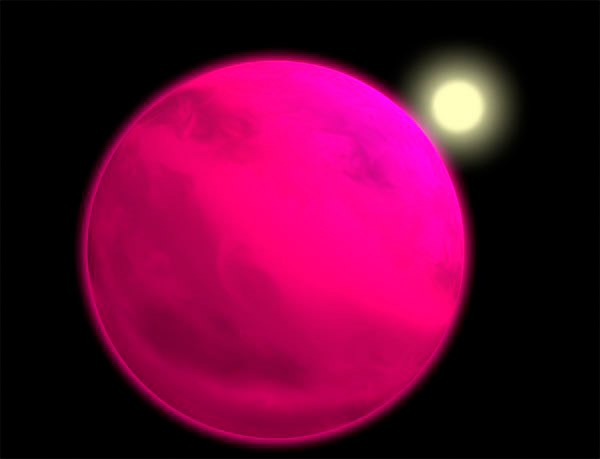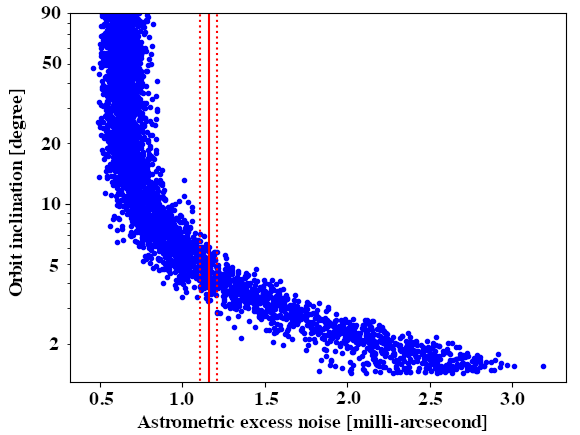THE OBJECT ORBITING THE STAR HD 114762, DISCOVERED IN 1989 : A DWARF STAR, NOT AN EXOPLANET
In 1989, an object was discovered in orbit around the star HD 114762. Its characteristics could suggest that this companion was an extrasolar planet, but no definitive conclusion was drawn and its exact nature remained uncertain. Today, a young researcher from the Institut d'Astrophysique de Paris shows that this companion is not a planet but a low mass star, using Gaia satellite data. This result confirms that 51 Peg b is indeed the first extrasolar planet discovered around a solar-type star (in 1995), a major discovery of the 20th century, that has earned its authors, Michel Mayor and Didier Queloz, the Nobel Prize in Physics 2019.
 Figure 1 : Artist view of a companion brown dwarf orbiting its host-star, in the background (credit: Observatoire de Paris / UFE).
Figure 1 : Artist view of a companion brown dwarf orbiting its host-star, in the background (credit: Observatoire de Paris / UFE).
In 1995, at the Observatoire de Haute-Provence (in French), the astronomers Michel Mayor and Didier Queloz discovered 51 Peg b, the first planet in orbit around a star similar to the Sun. This discovery was a real revolution in astrophysics. Since then, more than 4000 other extrasolar planets have been detected, making it possible to explore the diversity of planetary systems, to better understand their modes of formation and evolution, and opening the way to the detection of potentially habitable planets.
The exoplanet 51 Peg b was detected indirectly by the so-called “radial velocity” method. This technique makes it possible to measure the minute periodic variations in velocity of a star caused by the presence of a companion in orbit around it, this companion can be a planet or another star. Unfortunately, in most cases, because the radial velocity method can only measure the velocity variation along the observed direction, it is not possible to know the real mass of the companion; only a minimum mass value is measured. Thus, if it happens that the plane of the orbit of a companion is located exactly in the plane of the sky, no variation in velocity of the main star will be detectable. It is however necessary to know the mass to determine the nature of such a companion: if the mass is close to that of the Earth or Jupiter, it is indeed a planet; if the mass is greater than about 13 times the mass of Jupiter, the companion is a brown dwarf (an intermediate object between a star and a planet) or even possibly a star (more than 80 times the mass of Jupiter). In the case of 51 Peg b, it was shown that it is a planet, about half the mass of Jupiter.
However, in 1989, a companion was discovered around star HD 114762 by the radial velocity method. The results then showed that its mass was at least 11 times that of Jupiter, but the actual mass remained unknown. The minimum mass being high, it seemed unlikely that this companion be planetary in nature. Its discovery did not impulse the revolution that occurred six years later with the detection of 51 Peg b. Subsequently, several clues suggested that the companion of HD 114762 was not a massive planet, but rather a brown dwarf or a red dwarf star (that is a less massive and less hot star than the Sun). Yet, its exact nature remained uncertain and debated.
Today, the Gaia satellite makes it possible to determine the nature of HD 114762's companion. Gaia est une mission de l’European Space Agency which measures extremely accurately the position and the movement of over a billion of stars on the sky. These data make it possible to indirectly detect stellar or even planetary companions of the stars observed, and to measure their masses. When the final Gaia data becomes available, after 2022, the precise masses of thousands of extrasolar planets, brown dwarves and multiple stars will be measured.
 Figure 2 : Simulation of the excess of astrometric noise (positional variations) of the star HD 114762 according to the inclination of its companion's orbit. The red vertical lines indicate the Gaia measurement and its error bars; they allow one to infer a 6º inclination (with an error margin of -1.3º and +2.0º) for the companion's orbit, and an actual mass of the companion between 82 et 139 Jupiter masses, with a confidence level of 68.3% (credit: Flavien Kiefer)
Figure 2 : Simulation of the excess of astrometric noise (positional variations) of the star HD 114762 according to the inclination of its companion's orbit. The red vertical lines indicate the Gaia measurement and its error bars; they allow one to infer a 6º inclination (with an error margin of -1.3º and +2.0º) for the companion's orbit, and an actual mass of the companion between 82 et 139 Jupiter masses, with a confidence level of 68.3% (credit: Flavien Kiefer)
Using the first data obtained by Gaia, Flavien Kiefer, a postdoctoral researcher at the Institut d'Astrophysique de Paris, developed an innovative method to estimate the actual mass of some star companions. He applied it to the HD 114762 star to try to reveal, finally, the real nature of his companion.
This method consists in carrying out a series of simulations of the possible orbits of the companion of HD 114762, by testing in each simulation a different angle for the inclination of the orbit relative to the plane of the sky, seen from the Earth. The simulations that best reproduce the positional changes of HD 114762 on the celestial vault measured with GAIA, determine the inclination of the orbit: an inclination of 6º is deduced (Figure 2), that is an orbit almost seen face-on (with an inclination of 90º, it would be seen edge-on). Thanks to the orbital parameters of the companion object, deduced from the radial velocity variations of HD 114762 (measured by ground spectrographs), the value of the inclination makes it possible to estimate the mass of the companion.
The variations in the position of HD 114762 measured by Gaia are of the order of 1.1 milli-arcseconds (Figure 2), which is much higher than what is expected for this type of star. Using this measure, Flavien Kiefer was able to deduce that the actual mass of its companion was about 110 times higher than that of Jupiter (one tenth of the mass of the Sun). This clearly places this object outside the domain of planets. Thirty years after its discovery, the nature of the star orbiting HD 114762 is finally known: it is not a planet but a red dwarf star.
51 Peg b, whose discovery is celebrated in Stockholm on December 10, 2019, by the awarding of the Nobel Prize in Physics to Michel Mayor and Didier Queloz (half shared with James Peebles for his work in cosmology), is the very first planet ever detected around a star similar to the Sun.
Liens
![]() Nobel Prize in Physics 2019: James Peebles, Michel Mayor et Didier Queloz
Nobel Prize in Physics 2019: James Peebles, Michel Mayor et Didier Queloz
![]() Article in the Astronomy and Astrophysics journal: Volume 632, L9, 2019 (public access: arXiv)
Article in the Astronomy and Astrophysics journal: Volume 632, L9, 2019 (public access: arXiv)
![]() 2019 Highlight of the Astronomy and Astrophysics journal on the article above - also announced on the Twitter @AandA_journal and Facebook (in French) accounts of the journal
2019 Highlight of the Astronomy and Astrophysics journal on the article above - also announced on the Twitter @AandA_journal and Facebook (in French) accounts of the journal
Writing and contacts
- Flavien Kiefer
Institut d’Astrophysique de Paris, CNRS, UPMC
flavien.kiefer [at] iap [dot] fr
- Guillaume Hébrard
Institut d’Astrophysique de Paris, CNRS, UPMC
guillaume.hebrard [at] iap [dot] fr
Web writing: Valérie de Lapparent
Layout and iconography: Jean Mouette
December 2019
